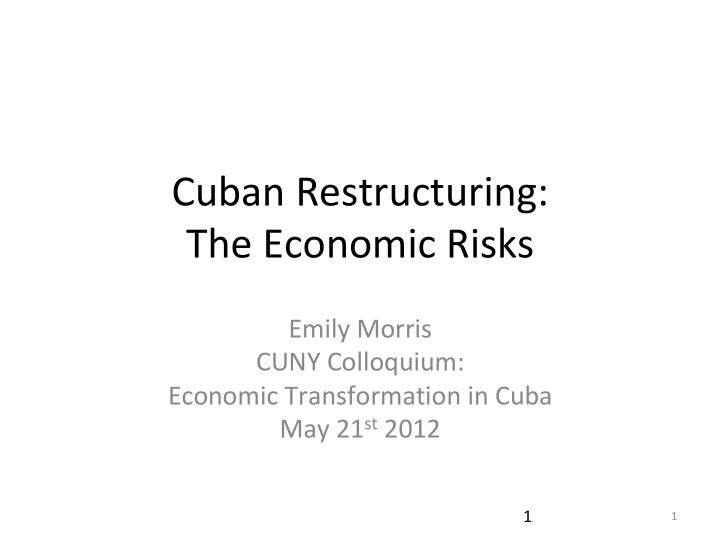



Cuban Restructuring: The Economic Risks Emily Morris CUNY Colloquium: Economic Transformation in Cuba May 21 st 2012 1 1
Economic risks 1. Unemployment l the cost of higher productivity? 2. Monetary instability l prices, exchange rate 3. Fiscal crisis l loss of capacity for social protection? 4. Stagnation l is Cuba stuck? 2 2
Actualización in perspective: Growth performance 15.0 Boom ̶ and 10.0 Crisis & its limits Real GDP growth, % 5.0 instability - Stabilisation -5.0 & recovery -10.0 -15.0 1990 1991 1992 1993 1994 1995 1996 1997 1998 1999 2000 2001 2002 2003 2004 2005 2006 2007 2008 2009 2010 2011 An achievement, but not a success 3
Unemployment: the cost of higher productivity? 160 140 Disguised unemployment 120 Index, 1990 = 100 as survival strategy Over-full 100 employment? 80 Subsidised 60 Underemployment? Job creation 40 through growth 20 0 1990 1991 1992 1993 1994 1995 1996 1997 1998 1999 2000 2001 2002 2003 2004 2005 2006 2007 2008 2009 2010 2011 Real GDP Employment Average productivity per worker Low risk: official policy commitment employment subsidy 4
Monetary instability : prices Inflation 350 Shortages low Stabilization & & rations: 300 BUT recovery: sharing prices improvement 250 hunger Index, 1990=100 controlled 200 & real wages 150 low 100 50 0 1990 1991 1992 1993 1994 1995 1996 1997 1998 1999 2000 2001 2002 2003 2004 2005 2006 2007 2008 2009 2010 2011 Cost of living ? Nominal average wage Average real wage ? Low risk: price liberalisation slow due to public fears 5
Monetary instability : exchange rate 0.20 CUP:CUP stable 0.18 Black But 0.16 market unorthodox gulf between 0.14 rate stabilisation ‘official’ 0.12 collapse and and 0.10 = shared legalisation ‘Cadeca’ 0.08 hardship rates 0.06 0.04 0.02 0.00 1990 1991 1992 1993 1994 1995 1996 1997 1998 1999 2000 2001 2002 2003 2004 2005 2006 2007 2008 2009 2010 2011 US$:CUP Low risk of exchange rate collapse – but is appreciation needed? 6
Monetary imbalance : exchange rate 60 Black 50 market CUP stable Stabilisation rate 40 BUT and collapse still legalisation 30 = very US$ 20 weak privilege 10 0 1990 1991 1992 1993 1994 1995 1996 1997 1998 1999 2000 2001 2002 2003 2004 2005 2006 2007 2008 2009 2010 2011 US$100 as multiple of average monthly wage at Cadeca rate Fragmented economy: official & unofficial prices, wages, exchange rates 7
Fiscal crisis: loss of capacity for social protection? 100 80 Fiscal rectitude 60 Big Spending surge Government; % of GDP & 40 monetised readjustment: 20 deficit The institutional test 0 1990 1991 1992 1993 1994 1995 1996 1997 1998 1999 2000 2001 2002 2003 2004 2005 2006 2007 2008 2009 2010 2011 -20 -40 Spending Revenue Balance Low risk of fiscal crisis: commitment, institution-building 8
Stagnation: is the Cuban economy stuck? • Unemployment : low risk - high commitment to full employment Ø slow productivity growth = bad for growth • Inflation : low risk - fear of rising cost of living Ø distorted prices persist = bad for growth • Fiscal crisis : low risk - discipline and high taxes Ø squeeze on public and private investment = bad for growth • So where is growth coming from?? v Disruption is necessary; can it be managed? 9
Cuban Restructuring: The Economic Risks Managing risk: an evolutionary-institutional process emily.morris@sas.ac.uk 10 10
Recommend
More recommend